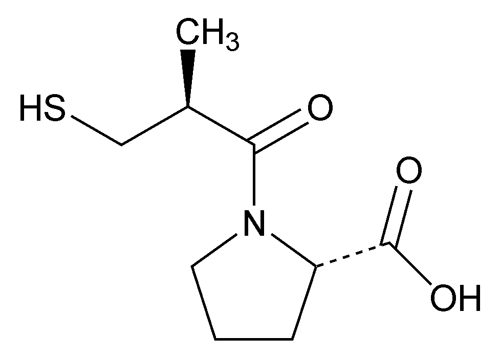Captopril
l-Proline, 1-[(2S)-3-mercapto-2-methyl-1-oxopropyl]-.
1-[(2S)-3-Mercapto-2-methylpropionyl]-l-proline
» Captopril contains not less than 97.5 percent and not more than 102.0 percent of C9H15NO3S, calculated on the dried basis.
Packaging and storage—
Preserve in tight containers.
Identification, Infrared Absorption  197K
197K .
.
Loss on drying  731
731 —
Dry it in vacuum at 60
—
Dry it in vacuum at 60 for 3 hours: it loses not more than 1.0% of its weight.
for 3 hours: it loses not more than 1.0% of its weight.
Residue on ignition  281
281 :
not more than 0.2%.
:
not more than 0.2%.
Heavy metals, Method II  231
231 :
0.003%.
:
0.003%.
Related compounds—
Mobile phase—
Prepare a filtered and degassed mixture of a 9 in 100 solution of tetrahydrofuran in methanol and a 1 in 2000 solution of phosphoric acid in water (33:67). Make adjustments if necessary (see System Suitability under Chromatography  621
621 ).
).
Resolution solution—
Dissolve USP Captopril RS, USP Captopril Disulfide RS, and 3-acetylthio-2-methylpropanoic acid in methanol to obtain a stock solution containing about 0.1 mg of each per mL. Quantitatively dilute a portion of this stock solution with methanol to obtain a solution containing about 10 µg of each Reference Standard per mL.
Standard solution—
[note—Use low-actinic glassware.] Dissolve an accurately weighed quantity of USP Captopril Disulfide RS in methanol and dilute quantitatively, and stepwise if necessary, with methanol to obtain a solution having a known concentration of 10 µg per mL.
Test solution—
[note—Use low-actinic glassware.] Transfer 50 mg of Captopril, accurately weighed, to a 25-mL volumetric flask. Dissolve the specimen in methanol, dilute with methanol to volume, mix, and use the solution promptly.
Chromatographic system
(see Chromatography  621
621 )—The liquid chromatograph is equipped with a 220-nm detector and a 3.9-mm × 30-cm column that contains packing L1. The flow rate is about 1 mL per minute. Chromatograph the Resolution solution (about 20 µL), and record the peak responses as directed for Procedure: the relative retention times are about 0.32 for captopril, 0.42 for 3-acetylthio-2-methylpropanoic acid, and 1.0 for captopril disulfide; and the resolution, R, between captopril and 3-acetylthio-2-methylpropanoic acid is not less than 3.0.
)—The liquid chromatograph is equipped with a 220-nm detector and a 3.9-mm × 30-cm column that contains packing L1. The flow rate is about 1 mL per minute. Chromatograph the Resolution solution (about 20 µL), and record the peak responses as directed for Procedure: the relative retention times are about 0.32 for captopril, 0.42 for 3-acetylthio-2-methylpropanoic acid, and 1.0 for captopril disulfide; and the resolution, R, between captopril and 3-acetylthio-2-methylpropanoic acid is not less than 3.0.
Procedure—
[note—Use the peak areas where peak responses are indicated.] Separately inject equal volumes (about 20 µL) of the Standard solution and the Test solution into the chromatograph, record the chromatograms, and measure the peak responses. Calculate the percentage of captopril disulfide in the portion of Captopril taken by the formula:
100(CS / CU)(rU / rS)
in which CS is the concentration, in µg per mL, of USP Captopril Disulfide RS in the Standard solution; CU is the concentration, in µg per mL, of Captopril in the Test solution; and rU and rS are the captopril disulfide peak responses obtained from the Test solution and the Standard solution, respectively: not more than 1.0% of the captopril disulfide is found. Compare the peak responses, excluding those of the solvent, captopril, and captopril disulfide, in the chromatogram of the Test solution with the main peak response in the chromatogram of the Standard solution: the peak response of each impurity does not exceed 40% of the main peak response in the chromatogram of the Standard solution (0.2%), and the sum of the impurity peak responses does not exceed the main peak response in the chromatogram of the Standard solution (0.5%).
Assay—
0.1 N Potassium iodate titrant—
Dissolve 3.567 g of potassium iodate, previously dried at 110 to constant weight, in water to make 1000.0 mL.
to constant weight, in water to make 1000.0 mL.
Procedure—
Dissolve about 300 mg of Captopril, accurately weighed, in 100 mL of water in a suitable glass-stoppered flask, add 10 mL of 3.6 N sulfuric acid, 1 g of potassium iodide, and 2 mL of starch TS. Titrate with 0.1 N Potassium iodate titrant to a faint blue endpoint that persists for not less than 30 seconds. Perform a blank determination (see Titrimetry  541
541 ), and make any necessary correction. Each mL of 0.1 N Potassium iodate titrant is equivalent to 21.73 mg of C9H15NO3S.
), and make any necessary correction. Each mL of 0.1 N Potassium iodate titrant is equivalent to 21.73 mg of C9H15NO3S.
Auxiliary Information—
Please check for your question in the FAQs before contacting USP.
Chromatographic Column—
| Topic/Question | Contact | Expert Committee |
| Monograph | Sujatha Ramakrishna, Ph.D.
Scientist 1-301-816-8349 |
(MDCV05) Monograph Development-Cardiovascular |
| Reference Standards | Lili Wang, Technical Services Scientist 1-301-816-8129 RSTech@usp.org |
USP32–NF27 Page 1779
Chromatographic columns text is not derived from, and not part of, USP 32 or NF 27.
